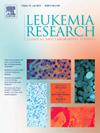中期骨髓评估在急性髓性白血病中的作用——一项系统回顾和荟萃分析。
IF 2.2
4区 医学
Q3 HEMATOLOGY
引用次数: 0
摘要
背景:目前接受强化诱导化疗的急性髓性白血病(AML)患者的护理标准包括在第14天左右(D14BM)进行中期骨髓活检,并对D14BM上残余细胞超过 % (D14BM阳性)的患者进行再诱导。然而,这种方法已经变得越来越有争议。本系统综述和荟萃分析评估了D14BM在接受一个周期诱导化疗的患者中的敏感性、特异性和预测价值,并评估了D14BM阳性患者再诱导与观察的疗效。方法:采用PubMed、Embase、Web of Science、Cochrane等数据库进行系统文献检索。双变量模型用于合并敏感性和特异性。阳性预测值是根据汇总的平均敏感性、特异性和难治性白血病的历史患病率来估计的。对完全缓解(CR)的风险比(RR)进行荟萃分析,比较D14BM阳性患者的再诱导和观察。结果:1044篇文献中,有12篇符合纳入标准。10项研究(1683例患者)评估了D14BM的预测价值,其敏感性为49.7 %(阳性D14BM正确识别的难治性病例比例),特异性为86.2 %。估计阳性预测值为38.9 %,假设真正难治性白血病的患病率为15 %。11项研究(832例患者)评估了再诱导对cr的疗效,合并RR为1.00(61 %对60 %,95 % CI: 0.76-1.31)。结论:D14BM阳性对难治性白血病的预测能力有限。与单独观察相比,基于阳性D14BM的再诱导不能提高CR率,并可能使患者暴露于过度的毒性。本文章由计算机程序翻译,如有差异,请以英文原文为准。
The role of interim bone marrow assessments in acute myeloid leukemia – A systematic review and meta-analysis
Background
The current standard of care for acute myeloid leukemia (AML) patients undergoing intensive induction chemotherapy includes an interim bone marrow biopsy around day 14 (D14BM), and reinduction for patients with more than 5 % residual blasts on D14BM (Positive D14BM). However, this approach has become increasingly controversial. This systematic review and meta-analysis assess the sensitivity, specificity, and predictive value of D14BM in patients treated with one cycle of induction chemotherapy and evaluate the efficacy of reinduction versus observation in patients with Positive D14BM.
Methods
A systematic literature search was conducted using PubMed, Embase, Web of Science, and Cochrane databases. A bivariate model was used for pooled sensitivity and specificity. The positive predictive value was estimated based on pooled mean sensitivity, specificity, and historical refractory leukemia prevalence. Risk ratios (RR) for complete remission (CR) were meta-analyzed to compare reinduction versus observation in Positive D14BM patients.
Result
Among 1044 identified articles, 12 met inclusion criteria. Ten studies (1683 patients) evaluated the predictive value of D14BM, with a sensitivity of 49.7 % (proportion of refractory cases correctly identified by Positive D14BM) and specificity of 86.2 %. The estimated positive predictive value was 38.9 %, assuming a 15 % prevalence of true refractory leukemia. Eleven studies (832 patients) evaluated efficacy of reinduction, with a pooled RR of 1.00 (61 % vs. 60 %, 95 % CI: 0.76–1.31) for CR.
Conclusion
Positive D14BM has limited predictive power for refractory leukemia. Reinduction based on Positive D14BM does not improve CR rates compared to observation alone only and may expose patients to undue toxicity.
求助全文
通过发布文献求助,成功后即可免费获取论文全文。
去求助
来源期刊

Leukemia research
医学-血液学
CiteScore
4.00
自引率
3.70%
发文量
259
审稿时长
1 months
期刊介绍:
Leukemia Research an international journal which brings comprehensive and current information to all health care professionals involved in basic and applied clinical research in hematological malignancies. The editors encourage the submission of articles relevant to hematological malignancies. The Journal scope includes reporting studies of cellular and molecular biology, genetics, immunology, epidemiology, clinical evaluation, and therapy of these diseases.
 求助内容:
求助内容: 应助结果提醒方式:
应助结果提醒方式:


